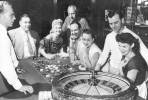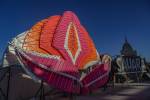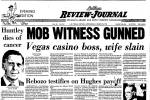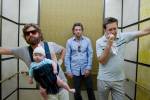Mob Museum celebrating Cuba’s impact on Las Vegas
Mob history buffs have heard of crime boss Charles “Lucky” Luciano — argued to be one of the founders of the mafia — but what about Santo Trasicont Jr.?
While most people are familiar with the role organized crime played in the casino industry in Las Vegas, the connections between the mafia here and in Cuba are often overlooked.
The Mob Museum is hoping to bring those connections to light.
“The Mob Museum tells the story of organized crime,” says Geoff Schumacher, director of content development for the museum. “We are looking to educate the public.”
Through a collection of artifacts and stories, the Mob Museum tells the history of organized crime and law enforcement. It doesn’t just focus on Las Vegas, but its impact on everywhere else, too.
Adding to its mission, the museum is hosting its Hot Havana Nights from 6 to 10 p.m. Thursday. The event, which costs $40, celebrates Cuban heritage through cuisine, art, music and dancing.
“The party is a combination of education but also celebration,” Schumacher says.
In addition to the event, the museum is having a seminar called “The Havana Underworld: Mafia Influence from Tampa to Cuba,” by author Scott Deitche to talk about the connections between Las Vegas and Cuba’s mob scene.
The event starts at 1 p.m. Saturday.
Schumacher says the program will give a historical snapshot of Cuba at that moment in time.
Pre-Fidel Castro, members of the mafia such as Luciano began opening casinos in the country, cultivating the gaming industry.
In its heyday, the hotel scene also brought in celebrities such as Marlon Brando.
Other connections include figures such as Wilbur Clark — who later opened the Desert Inn — who once handled entertainment at a hotel in Cuba and was even an investor in some properties.
Schumacher says the scene in Cuba in the 1950s rivaled the Las Vegas gambling industry.
But then Castro took over Cuba from then dictator Fulgencio Batista in 1958 and shut the casinos down.
With his rise, he got rid of gambling, and mob leaders took off.
In the mass exodus of Cubans who left the country, many were casino workers who found their way to Las Vegas to assume the same roles here.
Deitche plans to go over this history on Saturday.
“We will be going back to the late 1930s,” he says. “I will talk about how the mob rose to power and its legacy.”
Deitche says a lot of the mobsters in Las Vegas had ties to Cuba.
“Some had sizable holdings in Cuba,” he says.
According to Deitche, many people skim over the fact that there were many layers to mafia history.
“Most people end with (Lucky) Luciano in Havana,” he says. “He is one of the top-named characters talked about. Once you dig past that, you start finding out the other top names.”
One name people might stumble across, whom Deitche says he is most eager to discuss, is Santo Trasicont Jr., a powerful mob boss in Cuba.
Even though Havana’s past is often overlooked, Deitche says, he sees a changing tide in the way people look at the history.
He adds that with more research being done on the mafia, the Cuban connections are becoming more and more apparent.
During his talk, Deitche adds he plans to show many photos that haven’t been seen much anywhere else to give the audience member a good visual of Cuba’s history.
To put on the event, The Mob Museum has partnered with the Latin Chamber of Commerce and the Cuban Heritage Foundation.
According to Maria Caminero, the CEO with the Cuban Heritage Foundation, the organization has sponsored many events to celebrate Hispanic culture in general, let alone the Cuban aspects.
She said with more than 2,500 Cubans in Las Vegas, it is necessary to preserve and honor the culture.
“They’re all from different generations,” she says. “The majority have arrived within the last 10 years.”
Caminero says this event is also important because it highlights a forgotten aspect of history.
Unfortunately, Caminero says, the generation who arrived from Cuba right after Castro closed the casinos is long gone from Las Vegas.
“The last one died a couple years ago,” she says. “He was a dealer.”
However, she adds she was able to develop relationships with some of the people who arrived from Cuba in the ’50s and ’60s. Those workers had a unique perspective to see how the mob ran the casino industry in Cuba and then Las Vegas versus how corporations currently run the industry.
Aside from giving a snapshot of history, the event also helps cater to Las Vegas Hispanic culture — Clark County is 30 percent Hispanic, according to the U.S. Census Bureau.
“We have a very diverse audience who come to the museum,” Schumacher says.
He adds that the museum should be inclusive and keep them in mind when talking about mob history.
Schumacher says the museum plans to further accommodate other cultures by adding a Spanish language version of the website.
Starting in 2015, he says the museum is going to have an audio device that allows customers to walk through the museum at their own pace. The recording will be available in English, Spanish and Mandarin.
Looking toward the future, Hot Havana Nights might return to The Mob Museum.
“I envision this potentially becoming an annual event,” Schumacher says. “We can bring in different speakers and introduce different topics. This is a very rich history.”
Contact reporter Michael Lyle at mlyle@reviewjournal.com or 702-387-5201. Find him on Twitter: @mjlyle.
PREVIEW
What: Hot Havana Nights
When: 6-10 p.m. Thursday
Where: The Mob Museum, 300 E. Stewart Ave.
Admission: $40
What: Author’s talk with Scott Deitche
When: 1 p.m. Saturday
Where: The Mob Museum
Admission: Free with museum admission, which ranges from $10 to $19.95 depending on age and other special rates
































